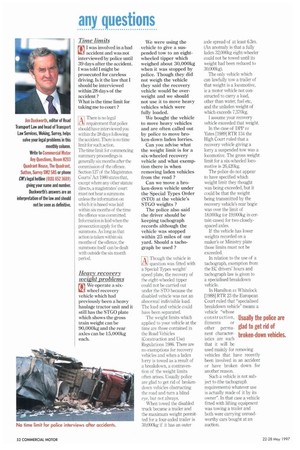Heavy recovery weight problems
Page 54

If you've noticed an error in this article please click here to report it so we can fix it.
We operate a six wheel recovery vehicle which had previously been a heavy haulage tractor unit and it still has the STGO plate which shows the gross train weight can be 90,000kg and the rear axles can be 15,000kg each. We were using the vehicle to give a suspended tow to an eightwheeled tipper which weighed about 30,000kg when it was stopped by police. Though they did not weigh the vehicle they said the recovery vehicle would be overweight and we should not use it to move heavy vehicles which were fully loaded.
We bought the vehicle to move heavy vehicles and are often called out by police to move broken-down laden lorries.
Can you advise what the weight limit is for a six-wheeled recovery vehicle and what exemption there is when removing laden vehicles from the road ?
Can we move a broken-down vehicle under the Special Types Order (STO) at the vehicle's STGO weights ?
The police also said the driver should be keeping tachograph records although the vehicle was stopped within 25 miles of our yard. Should a tachograph be used ?
A Though the vehicle in
question was fitted with a Special Types weight/ speed plate, the recovery of the eight-wheeled tipper could not be carried out under the ST() because the disabled vehicle was not an abnormal indivisible load. The load and vehicle could have been separated.
The weight limits which applied to your vehicle at the time are those contained in the Road Vehicles (Construction and Use) Regulations 1986. There are no exemptions for recovery vehicles and when a laden lorry is towed as a result of a breakdown, a contravention of the weight limits often arises. Usually police are glad to get rid of brokendown vehicles obstructing the road and turn a blind eye, but not always.
When towed the disabled truck became a trailer and the maximum weight permitted for a four-axled trailer is 30,000kg if it has an outer
axle spread of at least 6.3m. (An anomaly is that a fully laden 32,000kg eight-wheeler could not be towed until its weight had been reduced to 30,000kg).
The only vehicle which can lawfully tow a trailer of that weight is a locomotive, ie a motor vehicle not constructed to carry a load, other than water, fuel etc, and the unladen weight of which exceeds 7,370kg.
I assume your recovery vehicle exceeded that weight.
In the case of DPPvs Yates 119891 RTR 134 the High Court ruled that a recovery vehicle giving a lorry a suspended tow was a locomotive. The gross weight limit for a six-wheeled locomotive is 26,420kg.
The police do not appear to have specified which weight limit they thought was being exceeded, but it could be that the weight being transmitted by the recovery vehicle's rear bogie was over the limit of 1 8,000kg (or 19,000kg in certain cases) for two closelyspaced axles.
If the vehicle has lower weights recorded on a maker's or Ministry plate those limits must not be exceeded.
In relation to the use of a tachograph, exemption from the EC drivers' hours and tachograph law is given to a specialised breakdown vehicle.
In Hamilton vs Whitelock [1988] RTR 23 the European Court ruled that "specialised breakdown vehicle" means a vehicle "whose construction, fitments or other permanent characteristics are such that it will be used mainly for removing vehicles that have recently been involved in an accident or have broken down for another reason.
Such a vehicle is not subject to (the tachograph requirements) whatever use is actually made of it by its owner". In that case a vehicle fitted with lifting equipment was towing a trailer and both were carrying unroadworthy cars bought at an auction.
















































































































